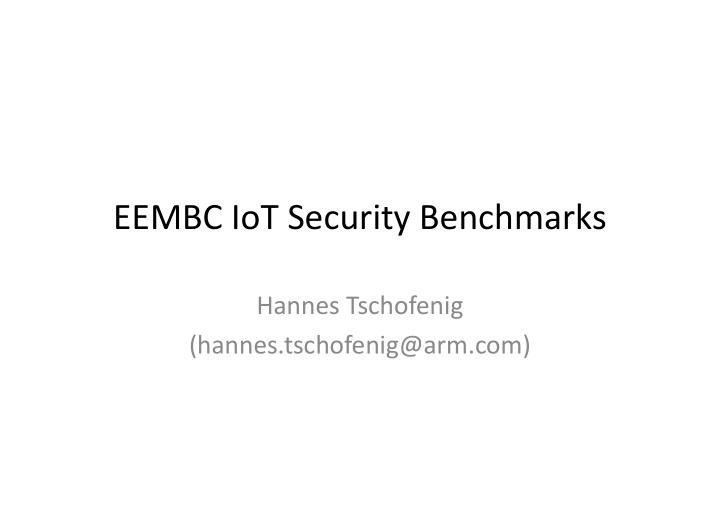



EEMBC IoT Security Benchmarks Hannes Tschofenig (hannes.tschofenig@arm.com)
IoT Devices cannot do crypto, right? • Wrong! • Looked at the performance of various state-of- the-art crypto operations on MCUs. – Presented the investigations in the LWIG working group. – Provided input to the 2015 NIST workshop on lightweight cryptography. • Hope was that others (e.g., researchers) help analyse the performance on other MCUs and do additional tests.
Some time later… • Unfortunately, we had to realize that most researchers care more about inventing new algorithms than analysing existing algorithms on available hardware. • We cannot run the tests on the wide range of MCUs from different vendors ourselves. • A dead end?
Embedded Microprocessor Benchmark Consortium (EEMBC) • It turns out that there is an organization that develops benchmarks for processors and MCUs and has been doing this since the late ‘90s. – For example, CoreMark is a synthetic benchmark that measures the performance of CPU used in embedded systems. • EEMBC has established groups working on benchmarks for IoT, which are called IoT- Connect, IoT-Secure and IoT-Gateway.
IoT Security Benchmark • Measurements: – Performance – Energy Efficiency – Memory • Tests have to work with different crypto implementations and with hardware from different vendors. • Initial selection is based on AES, SHA256, ECDH, ECDSA. • Group writes code for the tests and reference implementation uses mbed TLS crypto, libTomCrypt, and microECC.
Test Setup • Test setup re-used from IoT-Connect benchmark (but without radio manager).
Upcoming Work • To provide a synthetic benchmark we are investing the use of TLS/DTLS 1.2. • The idea is to take the performance of the individual cryptographic operations of common cipher suites and to sum them up. – Starting point is TLS_ECDHE_ECDSA_WITH_AES_128_CCM – This should approximate the cryptographic performance of the handshake (without taking packet parsing and network transmissions into account). – No real handshake actually executed. • We will compare the approximation with real world exchanges to determine the difference.
Looking Forward • Will add other implementations and other algorithms as well. Feedback and input appreciated. • Get in touch with us if you have experience with benchmarks and IoT security performance testing? • Could share info on the SAAG list as we make progress (if there is interest).
Questions?
Contact Information • IoT-Secure Benchmark Working Group Chairs: – Mike Borza (Mike.Borza@synopsys.com) – Ruud Derwig (Ruud.Derwig@synopsys.com) • EEMBC President – Markus Levy (markus.levy@eembc.org)
Recommend
More recommend